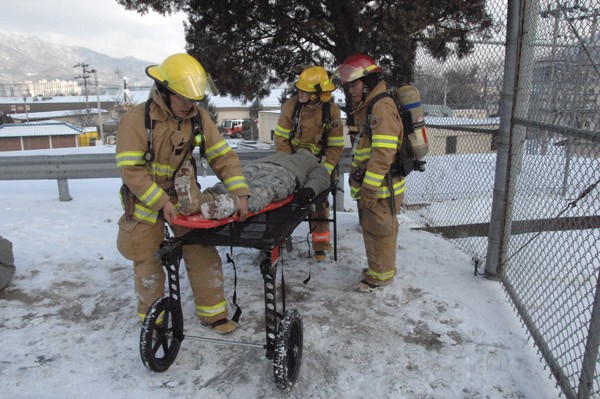
CASEY GARRISON South Korea - The leadership of Red Cloud Garrison and Casey Garrison came together with the leadership of the 2nd Infantry Division Feb. 18 to hold an Antiterrorism and Force Protection exercise to test how well Area I would respond when attacked.
One scenario involved the water treatment plant on Casey when a simulated chemical explosion took place simulating injuries to 12 Soldiers.
Response time for first responders was measured as well as the response time for the fire department and firefighters to come to the rescue of those pretending to be injured.
After treating the 12 with first-aid measures, they were transported by ambulance to Camp Mobile where they were medevaced to Yongsan 121 Hospital.
"The point of doing an exercise like this is to validate the antiterrorism plan we have in place," said Roger McBryar, Casey Garrison antiterrorism/force protection specialist. "The water treatment plant simulation is a requirement in testing our AT/FP plan and also testing the ability of our first responders in getting to the scene and evacuating the injured by assessing the casualties, treating the casualties, and medevacing them to the hospital."
McBryar follows a procedure in his AT/FP plan when there is emanate danger of attack. When he learns of the situation, he goes to the place; in this case the water treatment plan, and warns those in charge of what is about to happen.
"I went to the water treatment plant and identified myself to the manager," McBryar said. "He verified who I was before allowing me to enter, and told him we were expecting an attack now. I told him there was an explosion and he called 911."
The feigned explosion was to cause thick smoke causing the injured difficulty in breathing and coughing.
Cpl. Kim, Joon young, a Korean Augmentee to the United States Army, volunteered to be a casualty during the exercise and was to feign an injury caused by chemical smoke.
"I will have an airway obstruction due to chemical exposure," Kim said. "I pretended to have difficulty breathing and coughing a lot."
Soldiers volunteering to be casualties were required to lie down in the snow and look like casualties for the first responders when they came on the scene.
"My wound is chemical poisoning and muscle twitching," said Cpl. Kim, Bong woo. "I am supposed to be a guard on duty when the explosion happens."
"The varieties of wounds were planned before the exercise by David Newland of Directorate of Plans, Training, Mobilization and Security on Red Cloud Garrison," McBryar said. "We expect to learn here in the Information Operations Center from this scenario the ability of the staff to communicate and coordinate together to rapidly respond to the scene, evacuate, identify all the casualties and track them as we move through the exercise."
"The reason we are having this AT/FP exercise is because it is an annual requirement," said Michael Turrieta, director of DPTMS on Casey Garrison. "Basically we are implementing our procedures that are in place for a possible future terrorist attack. Hopefully, we will learn what our vulnerabilities are today. Finding where our enemies could hurt us most is our main objective."

Social Sharing